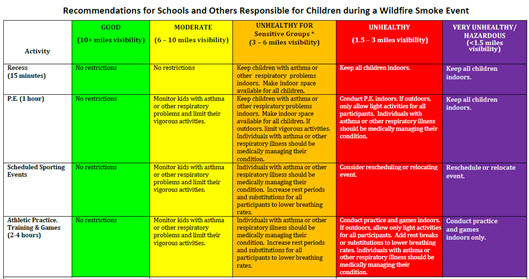 |
| Public health officials advise Idahoans to limit time outside as air quality worsens |
BOISE — Smoke from several wildfires in Idaho and surrounding states is affecting the air quality for residents in nearly every Idaho community and is expected to continue to do so for the next several days. Public health officials are advising people in the affected areas to limit their time outside as much as possible to reduce their exposure to smoke.
Wildfire smoke has severely reduced air quality across the Panhandle and south to the Clearwater drainages, as well as in southwest and southern Idaho. The Air Quality Index (AQI) for these areas has already reached levels for “Unhealthy,” “Very Unhealthy,” and “Hazardous” categories, and will continue to vary during the next few days. Residents should monitor the air quality when planning outdoor activities.

“Staying indoors is the best way to reduce exposure to smoke,” said Colby Adams, environmental health director for the Department of Health and Welfare. “If you have to be outside, remember that surgical masks, bandanas, and dust masks do not reduce the amount of smoke you breathe. For a respirator to provide protection against small particles in smoke, it must be certified by NIOSH (National Institute for Occupational Safety and Health) and fit with a tight seal around the mouth and nose. Respirators that provide protection from smoke particles also increase resistance to breathing, and their use should be limited to adults who are otherwise healthy. There are no respirators certified for use by children.”
Older adults, infants, children, and people with medical conditions such as asthma, lung disease, and heart disease are more sensitive to poor air quality and should reduce activity outdoors when air quality is moderate or worse. People who use inhalers for asthma or other conditions should keep them close at hand. Everyone is advised to seek medical treatment for uncontrolled coughing, wheezing, choking, or if breathing difficulties continue after they move indoors.
To reduce smoke exposure to protect people’s health, public health officials advise:
- Older adults, small children, and those with respiratory conditions or heart disease should stay indoors and avoid heavy work when air quality reaches unhealthy for sensitive groups levels
- Everyone should avoid heavy work or exercise outdoors when the air quality index reaches unhealthy levels.
- Monitor the Air Quality Index when available. Use visibility to determine air quality otherwise. When visibility is reduced to less than five miles, sensitive groups should limit activity. When visibility is reduced to less than three miles, air quality is considered unhealthy for everyone. Visibility of less than one mile is considered hazardous and everyone should avoid all physical activity outdoors.
- Stay cool if the weather is warm. If your home has a central air system, run your fan blower continuously to re-circulate and filter the indoor air. If possible, use a filter in your air conditioner that is designed to collect smoke particles.
- For homes without a central heating and/or cooling system, use portable air purifiers to remove particles (air purifiers that utilize HEPA filters are best; avoid using air purifiers that produce ozone).
- If you do not have clean indoor air, visit places in your community that have air conditioning, such as a library.
Daily updates on air quality conditions at various locations in Idaho are available on the Department of Environmental Quality’s Air Quality Reports and Forecasts webpage. For areas where air quality monitors are not available, the Visibility Range and AQI Table can help determine the necessary precautions to take. See activity guidelines for schools and additional information on how wildfire smoke can affect your health. For more complete information about wildfires in your area visit the Idaho Smoke Information Blog.
For media inquiries:
No comments:
Post a Comment